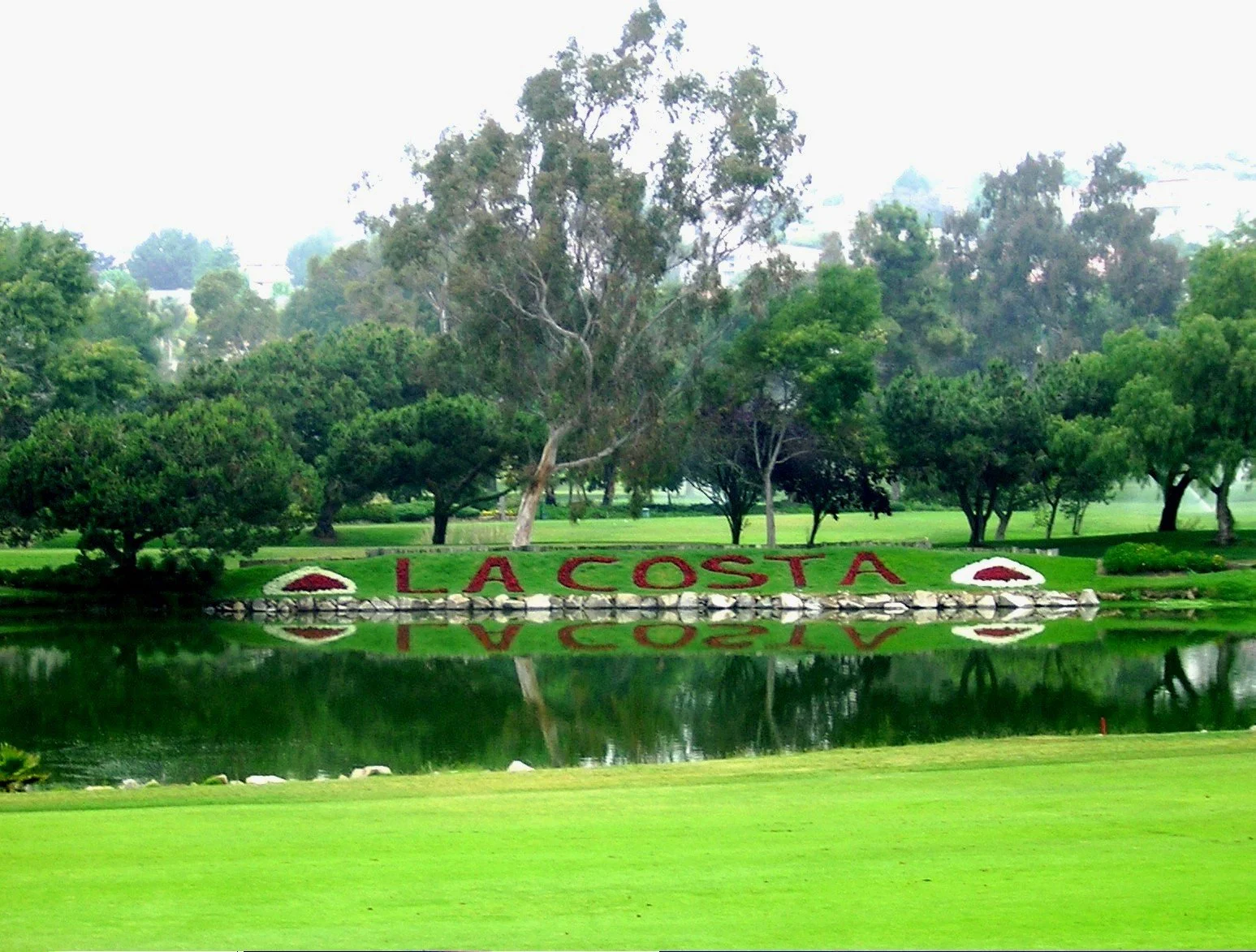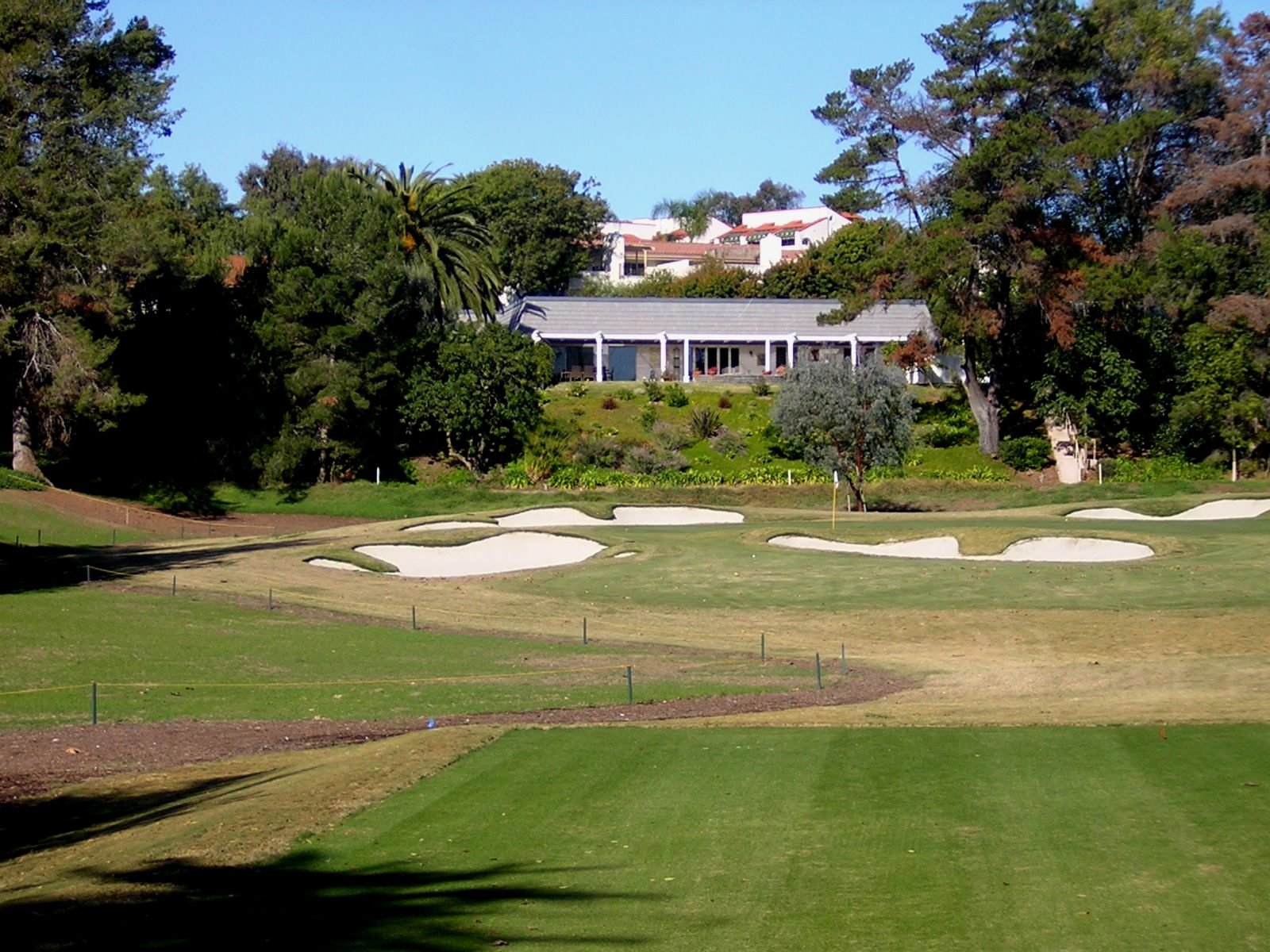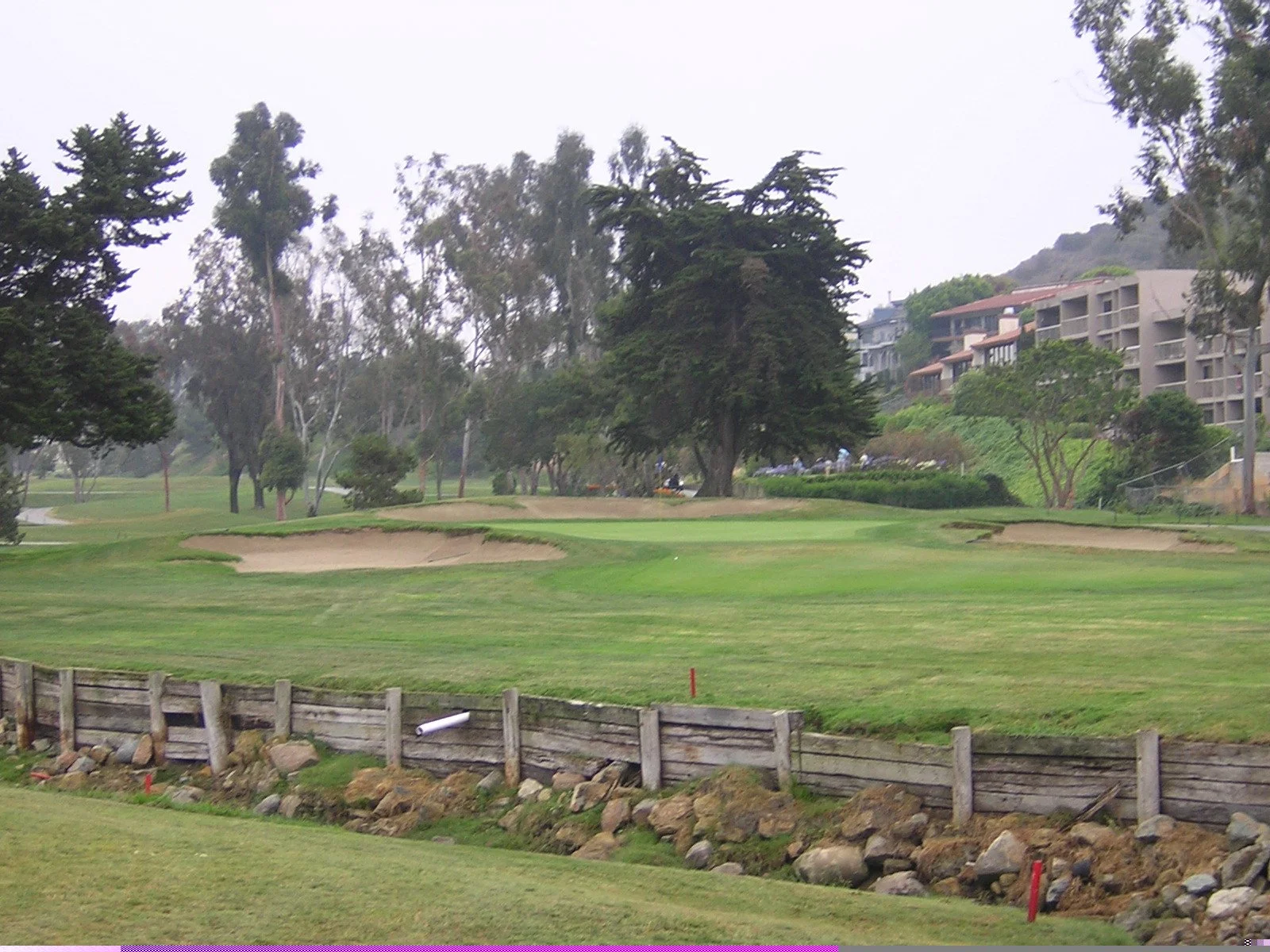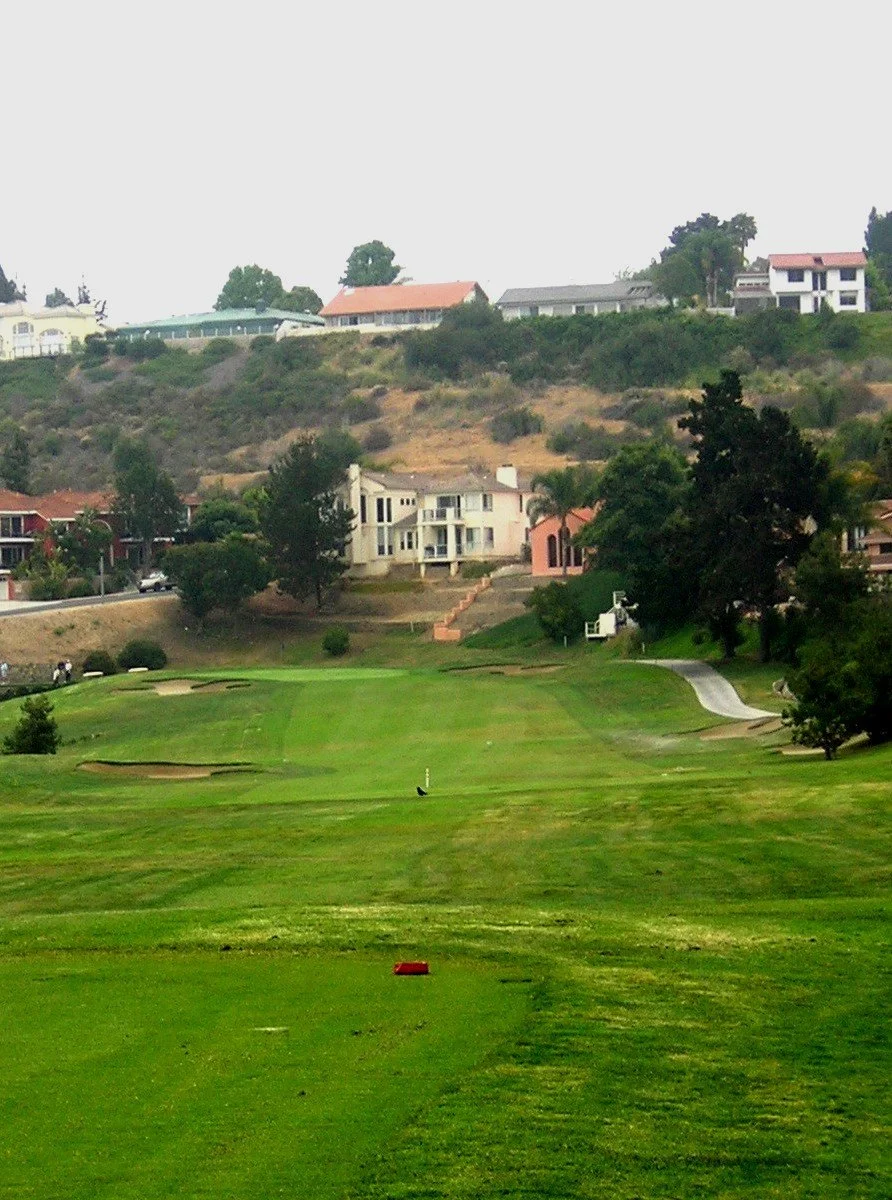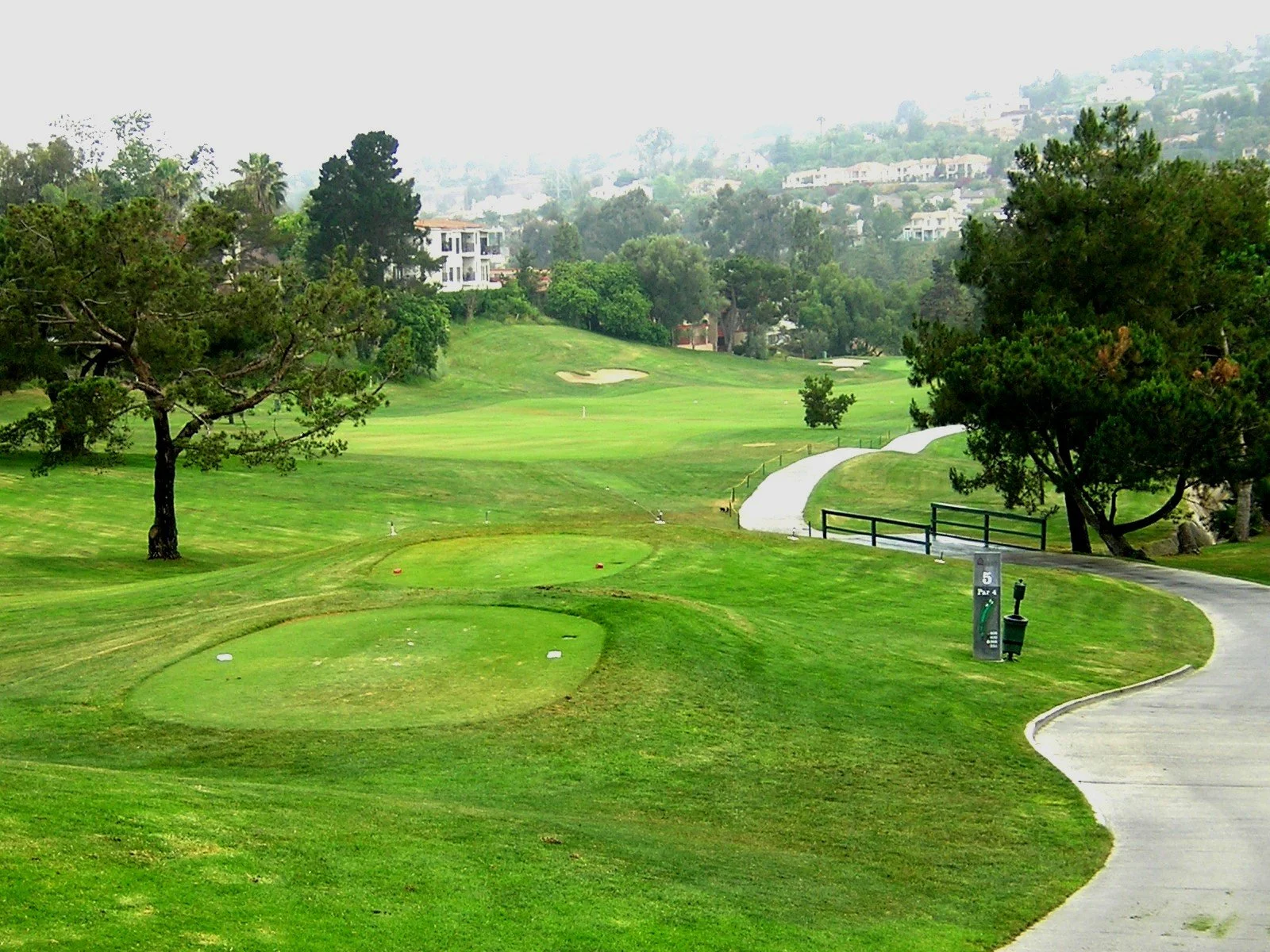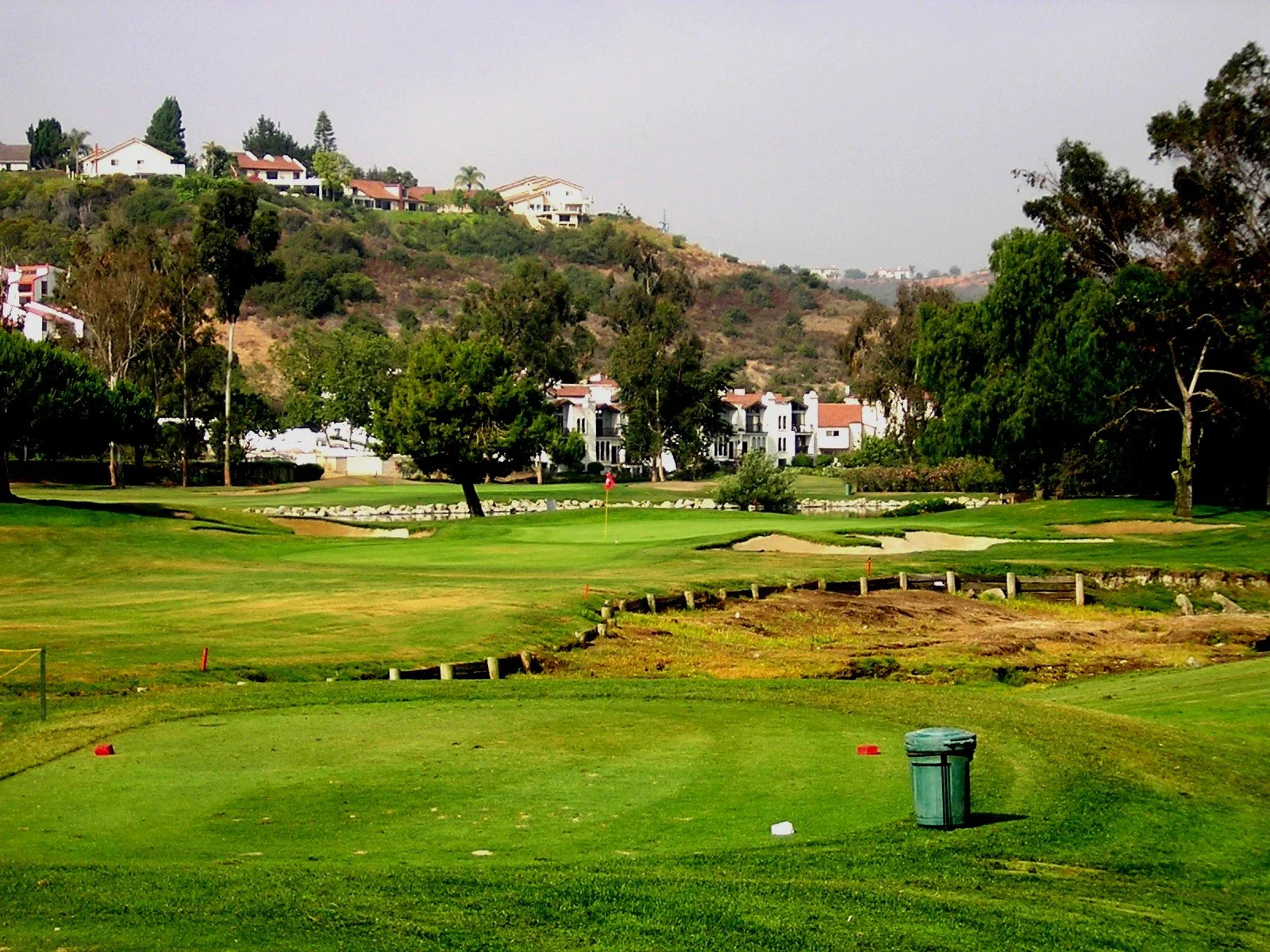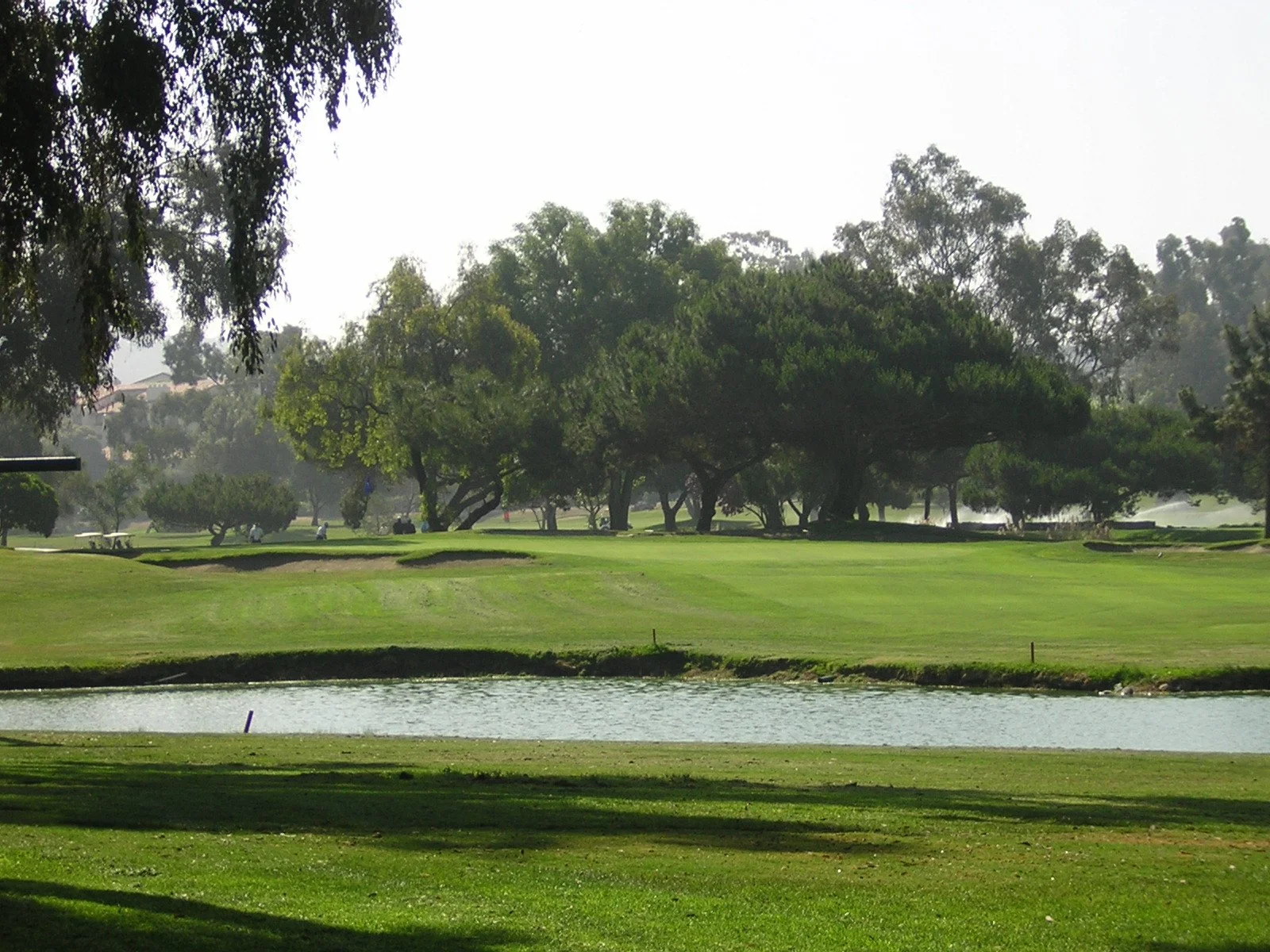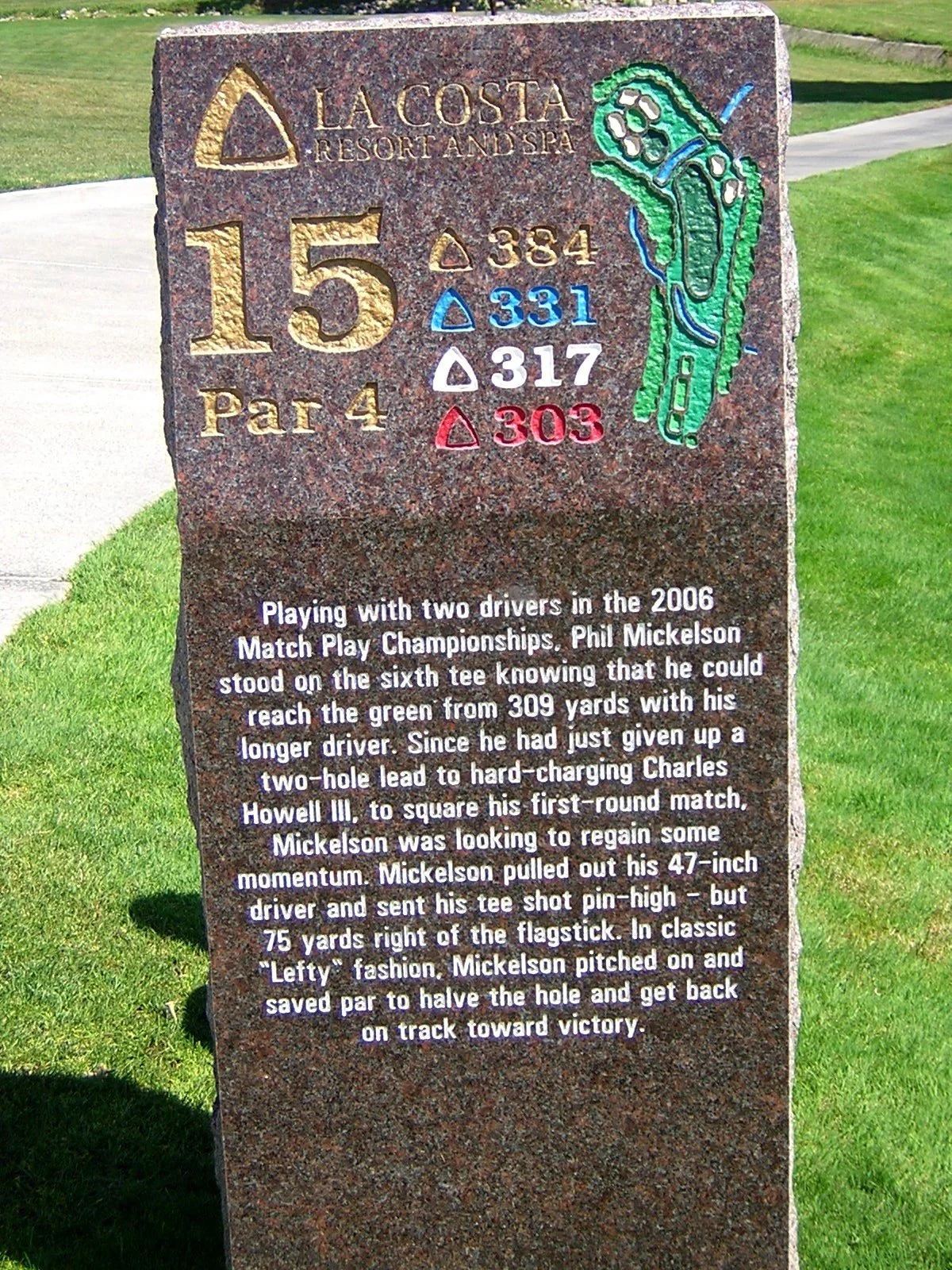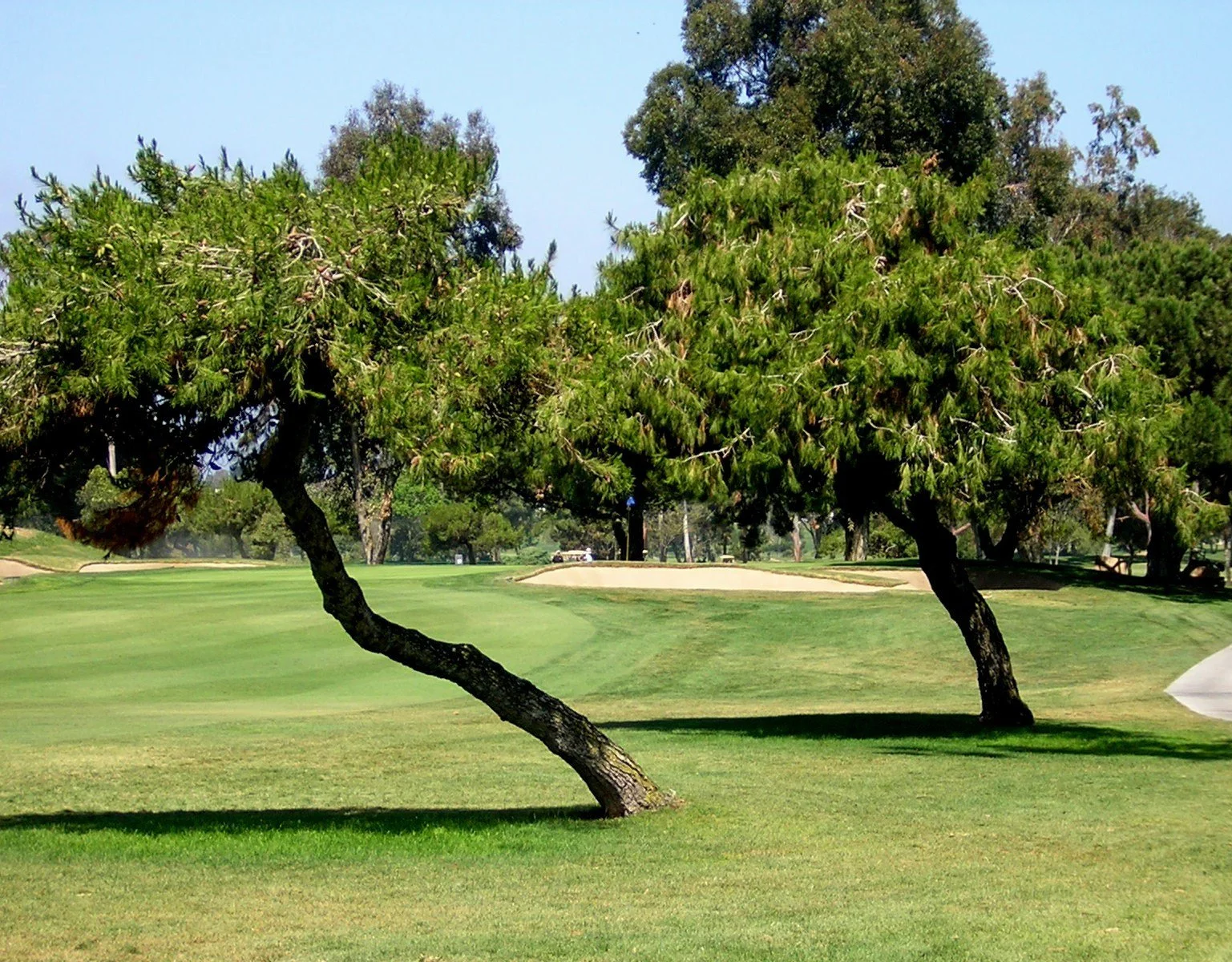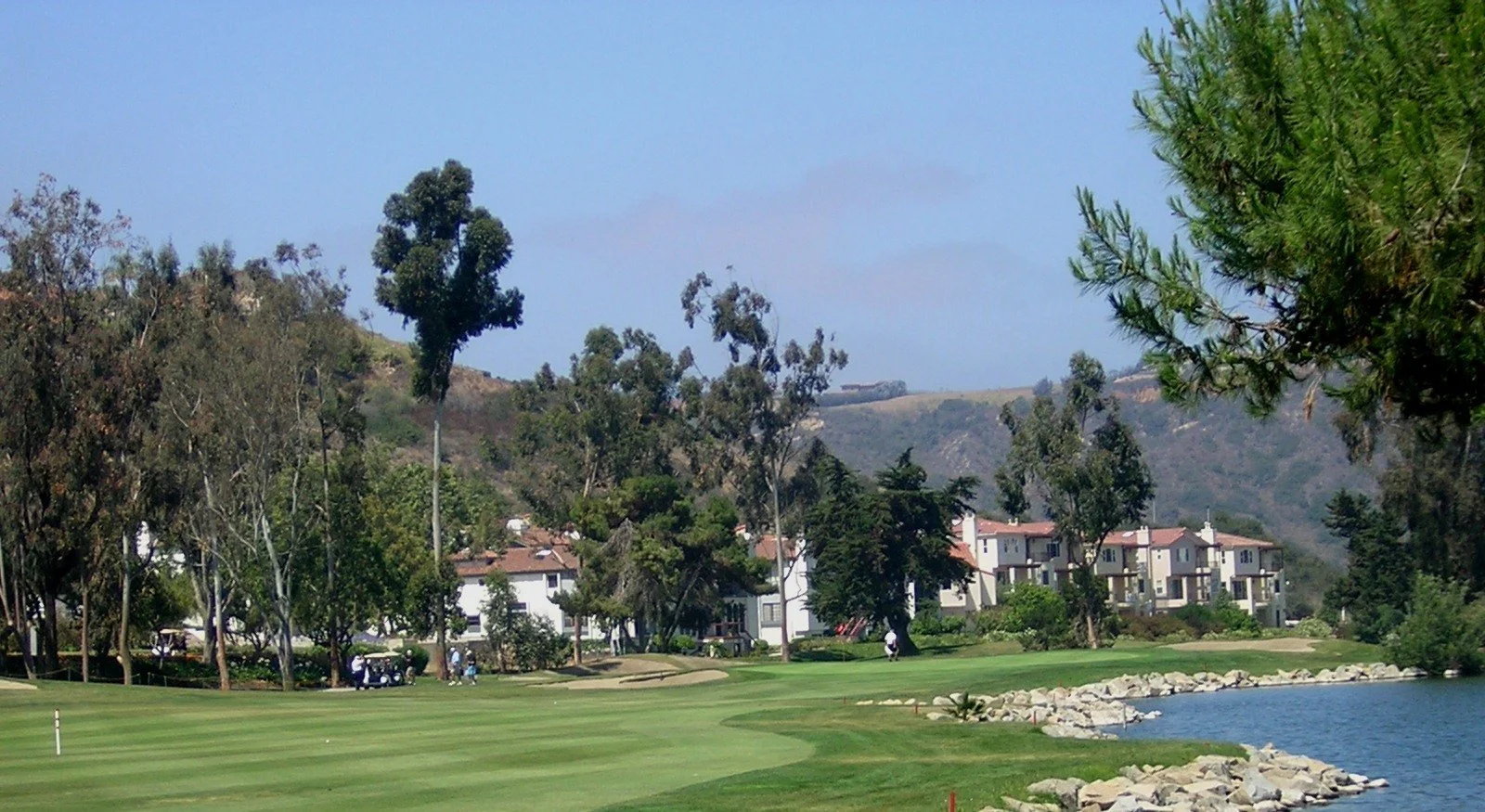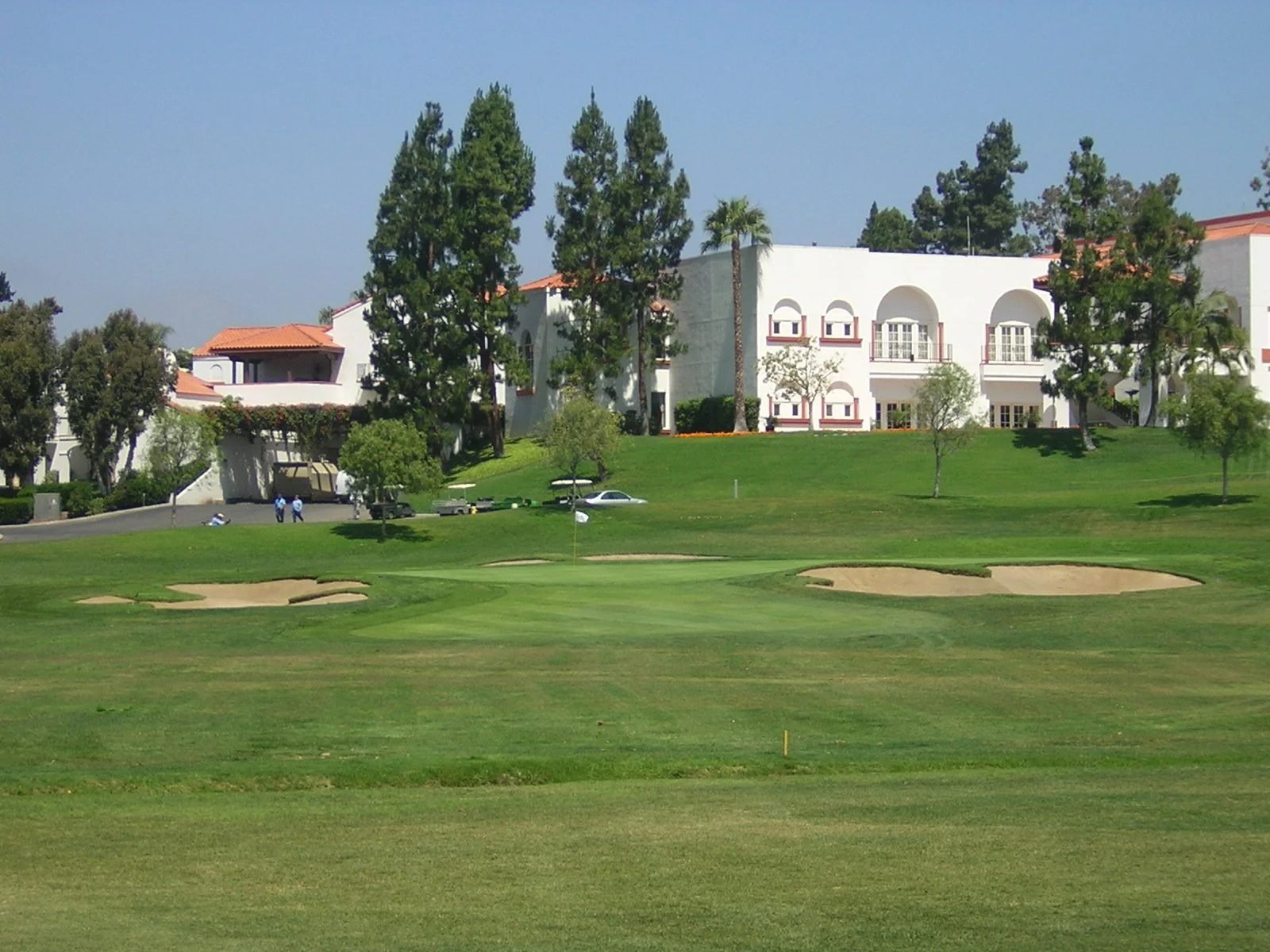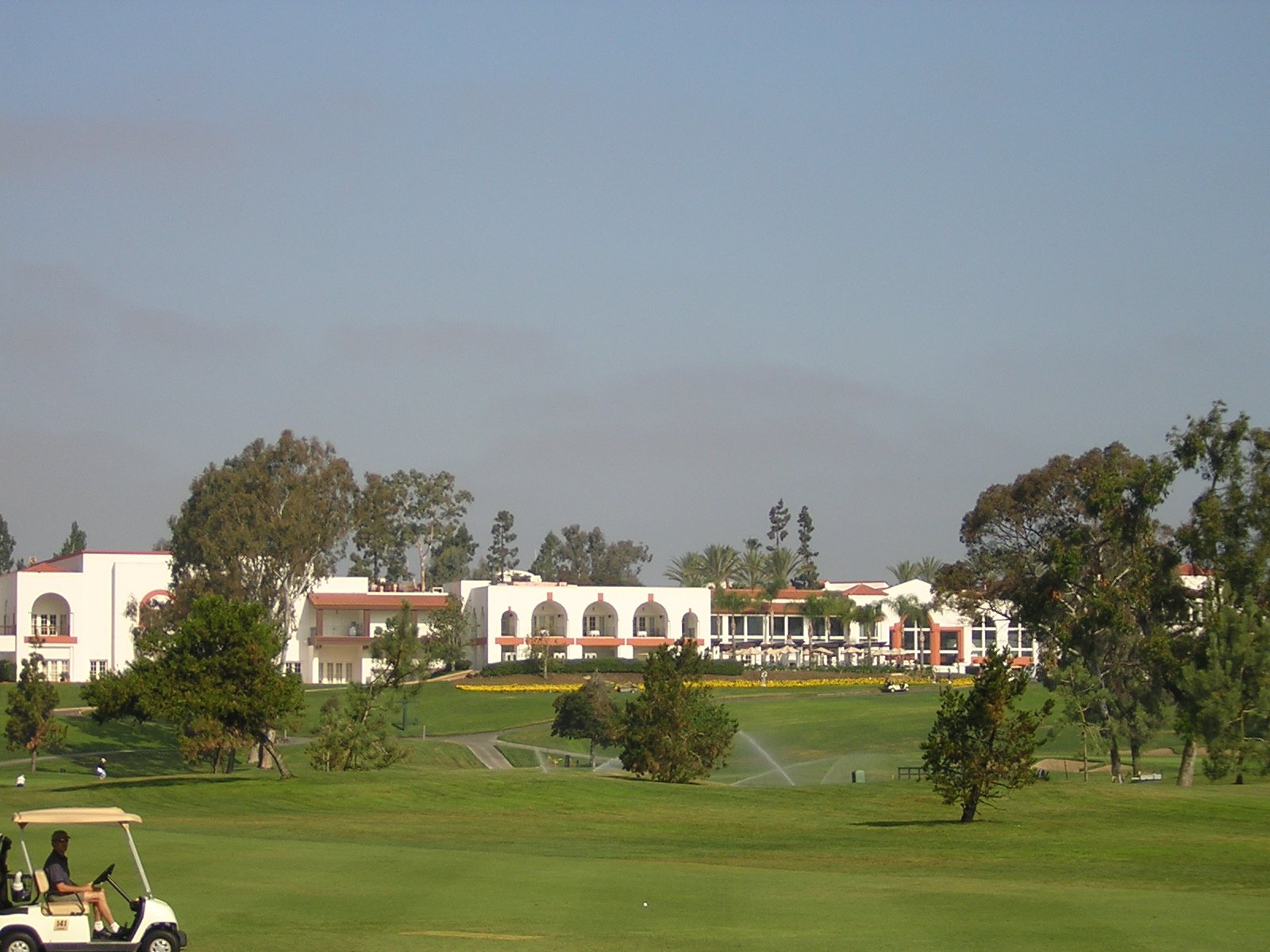LA COSTA RESORT & SPA
Champions Course Architects: Dick Wilson (1965), Joe Lee (1973),
Damian Pascuzzo/Jerry Pate with Jeff Brauer (2011)
Year Opened: 1965
Location: Carlsbad, California
Slope: 140. Rating: 75.1
Par: 72
Yardage: 7,172
Hole-by-Hole: 1 - Par 4 370 Yds 10 - Par 5 556 Yds
2 - Par 5 577 Yds 11 - Par 4 367 Yds
3 - Par 3 183 Yds 12 - Par 3 244 Yds
4 - Par 4 379 Yds 13 - Par 4 392 Yds
5 - Par 4 418 Yds 14 - Par 4 493 Yds
6 - Par 5 538 Yds 15 - Par 4 340 Yds
7 - Par 4 465 Yds 16 - Par 3 170 Yds
8 - Par 3 200 Yds 17 - Par 4 471 Yds
9 - Par 4 415 Yds 18 - Par 5 594 Yds
Par 36 3,545 Yds Par 36 3,627 Yds
South Course Architects: Dick Wilson (1965), Joe Lee (1973, 1984),
Damian Pascuzzo/Jerry Pate with Jeff Brauer (2011)
Year Opened: 1965
Location: Carlsbad, California
Slope: 136. Rating: 74.6
Par: 72
Yardage: 7,077
Hole-by-Hole: 1 - Par 4 392 Yds 10 - Par 4 450 Yds
2 - Par 4 357 Yds 11 - Par 3 210 Yds
3 - Par 4 467 Yds 12 - Par 5 587 Yds
4 - Par 4 371 Yds 13 - Par 4 448 Yds
5 - Par 4 406 Yds 14 - Par 3 211 Yds
6 - Par 3 170 Yds 15 - Par 4 384 Yds
7 - Par 5 501 Yds 16 - Par 4 428 Yds
8 - Par 3 166 Yds 17 - Par 5 575 Yds
9 - Par 5 494 Yds 18 - Par 4 460 Yds
Par 36 3,324 Yds Par 36 3,753 Yds
Key Events Held: California Amateur Championship (2014),
Kia Classic (2010, 2012),
WGC - Accenture Match Play Championship (1999-2000, 2002-06),
PGA Tour Qualifying School (2000),
Lexus Challenge (1996),
Mercedes Championships (1994-98),
Infiniti Tournament of Champions (1991-93),
MONY Tournament of Champions (1975-90),
Tournament of Champions (1969-74),
Haig Scotch Invitational (1967),
Haig & Haig Scotch Mixed Tournament (1965-66).
Awards Won: 4 1/2 stars by Golf Digest (North), Best Places to Play (2006-07),
4 stars by Golf Digest (South), Best Places to Play (2006-07),
Top 75 Golf Resorts in North America, Golf Digest (2002-06),
World's Best Golf Resorts, Travel & Leisure Golf Survey (2006),
Diamond Golf Resort Award, Luxury Golf & Travel (2006),
#3 Golf Resort in the West, Travel & Leisure Golf Survey (2005),
Top 100 Courses in California, Golfweek (2005),
Top 75 Courses in North America, Golf Digest (2004),
#2 by Travel Channel - Most Family Friendly Resort in U.S. (2010),
Gold Tee Award - Meetings & Conventions (1991-2002, 2006, 2011),
Fodor's Choice Award Hotel Diderot - Fodor's Travel (2011),
Top Women-Friendly Courses, Golf for Women.
Website: www.lacosta.com
HISTORY: Since opening in 1965 as the first resort in the United States with a full-service spa, La Costa Resort and Spa has been home to Hollywood and some of the greatest sports personalities. From Bob Hope, Bing Crosby and Frank Sinatra to Joe Namath, Mickey Mantle and Willie Mays, all of the superstars from yesteryear and today have graced the legendary fairways.
The original 18 holes at La Costa were designed by Dick Wilson, who passed away in the late 1960s, with an additional nine holes added by Joe Lee in 1973 and in 1984. The closing nine of the South Course are from Wilson's original design, while the other 27 holes are a combination of Wilson and Lee's work. Wilson and Lee both designed many courses around the United States, such as Bay Hill (Fla.) and Laurel Valley (Pa.) by Wilson and the Magnolia and Palm courses at Walt Disney World by Lee or their co-design work at Cog Hill (Ill.) and Doral (Fla.).
Set amongst the foothills of Carlsbad, just 35 miles north of San Diego, La Costa Resort and Spa rambles through over 400 acres of prime real estate in Southern California. Featuring classic and traditional design, La Costa is for all levels of golf, with four sets of tees and yardages ranging from 5,600 to just under 7,200 yards.
The professionals have been coming to La Costa ever since it first opened its doors, with such events as the Haig & Haig Scotch Mixed Tournament and the PGA Tour's Tournament of Champions.
After several years in Las Vegas, the TOC moved to La Costa thanks in part to Allard Roen, the event's first tournament director. Roen felt that the resort and golf courses were a perfect fit. "The respect the players have expressed has been gratifying," Roen commented. "They've shown that this is a golf course worthy of the caliber of players and the tournament itself."
Roen, you see, was the brainchild behind La Costa. A real estate entrepreneur in the early '60s, Roen discovered the remarkable area while riding horseback and joined with a partner to begin purchasing some of the land. Starting as a 90-room inn, La Costa has developed into a world-class resort and spa.
South African Gary Player captured the first TOC at La Costa back in 1969, as he defeated Lee Trevino by two shots. Player enjoyed his time at La Costa, winning the event again in 1978 and finishing runner-up on three other occasions. Player's winning score of four-under-par 284 remains the highest winning score in La Costa's TOC history.
Jack Nicklaus was another player who had great success at La Costa. The "Golden Bear" won the TOC at this venue three times with one second-place result. Joining Nicklaus as a three-time winner at La Costa was Tom Watson, who won back-to-back events in 1979 and '80 and again in 1984. With his win in '84, Watson recorded his 30th PGA Tour victory.
When Calvin Peete captured the 1986 tournament, Peete posted a record of 21-under par, winning by six shots over Mark O'Meara.
Notable champions of this glorious event at La Costa were Lee Trevino, Johnny Miller, Lanny Wadkins (twice), Tom Kite (twice), Davis Love III, Phil Mickelson (twice) and Tiger Woods.
Mickelson's victory in 1994 was the fourth of his career and it came in a playoff over Fred Couples. Mickelson, from the Southern California area, added his second title four years later by one over O'Meara and Woods.
The world's No. 1 player, Woods titled for the first time at La Costa in 1997, as he defeated Tom Lehman in a weather-shortened event. The newly created World Golf Championships - Accenture Match Play Championship came to La Costa in 1999, as Jeff Maggert outlasted Andrew Magee on the 38th hole. Maggert, the 24th seed, defeated Fred Funk, Nick Price, Bernhard Langer, Woods and Steve Pate en route to the final.
Darren Clarke, the only European to advance to the semifinals, defeated Woods in the 2000 event. Clarke played stellar golf in defeating Woods quite handily, 4 & 3.
In 2002, Kevin Sutherland became a first-time winner on Tour, as he defeated Scott McCarron, 1-up. On the final hole, Sutherland, who missed the green with his approach, blasted out of the sand to within a foot and when McCarron missed his eight-foot birdie putt, he earned his only PGA win.
With his win in 2003, Woods became the first player to sweep all four of the WGC events, as he clipped David Toms, 2 & 1. Woods opened up a huge 5-up lead after 19 holes, but Toms battled back to get within one down after a birdie on the 11th (29th hole). Woods, however, closed out the match with a three-foot par save on the 35th hole.
Woods made it two straight as he dispatched Love, 3 & 2, for his 40th career PGA Tour title in 2004. In doing so, Woods passed Watson and legendary golfer Gene Sarazen on the all-time wins list.
Toms gained a little redemption from his 2003 loss as he pasted Chris DiMarco, 6 & 5, in 2005. The win, the most lopsided in event history, was over early, as Toms won holes often, posting a 9-up lead after 26 holes. Toms' play over the week was quite amazing, as he recorded just four bogeys in 116 holes. Even after nine holes, Toms won seven of the next eight holes to put the match
away.
The final WGC - Match Play event held at La Costa was captured by Geoff Ogilvy as he knocked off Love III, 3 & 2. Ogilvy, who became just the second Australian to win a World Golf Championships event, played a record 129 holes to win the title. His first four matches went extra holes, including wins over Michael Campbell and Mike Weir. Ogilvy clipped Charles Howell III in the quarterfinals and then dispatched former British Open champion Tom Lehman to reach the final. Ogilvy's win was deemed a "Major" victory, as he knocked off former U.S. Open, Masters, British Open and PGA Championship winners.
The LPGA made its initial foray to La Costa in 2010, as Hee Kyung Seo routed the field in winning the Kia Classic by six shots over Inbee Park. Seo was the only player in the field with four subpar rounds as she recorded her only LPGA Tour title. Park, who started the final round 11 shots back, finished with a tournament-record 65 to place second. The course played quite difficult, as the cut came at five-over par.
Following the 2010 event, La Costa Resort and Spa enlisted the services of Damian Pascuzzo and Steve Pate, along with Jeff Brauer, to restore the integrity and tradition of the Champions Course (formerly the North Course).
Picking the right team to accomplish the $50 million investment to the resort by KSL Capital Partners was of utmost importance.
Certainly not widely known like the big boys of Dye, Fazio, Nicklaus or Doak, 2P Golf Course design made sense.
Former PGA Tour and current Champions Tour player Pate is California-bred, growing up in nearby Santa Barbara, and La Costa is very near and dear to his heart. "La Costa is one of the greatest places in the world," he said.
Not only did Pate see his first professional event at La Costa as a child, his second of six career PGA titles came at the Tournament of Champions in 1988. "I know that this project will do justice to Dick Wilson's work here and is a fitting tribute to La Costa's legacy," Pate added.
In all, every green on the Champions Course, along with four on the South Course, were replaced. In addition, some of the routing, contours, length, bunkering and drainage technology was either replaced, added or enhanced to the Champions Course.
"We have a lot of respect for La Costa's original design and have maintained its integrity," Damian Pascuzzo, one of the course architects, said. "We did a lot of research before starting to work on an historical golf site like this."
Changing the greens from turfgrass to bentgrass was a no-brainer. Not only did it conserve water, but it created a different flow to each putting surface.
Every bunker was modernized and sculptured, new lakes were added, the poor drainage of the past was improved throughout the resort, each hole on the Champions Course was expanded to six sets of tees, the 16th hole was completely redesigned and the course was lengthened over 75 yards.
"Our goal was to unveil an ideal combination of championship challenges within a user-friendly golf facility appealing to members and resort guests," Pascuzzo said.
Pate continued, "I know that this project will do justice to Dick Wilson's work here and is a fitting tribute to La Costa's legacy."
Addressing the drainage issues was critical.
In doing so, 3,000 truckloads of sand were brought in to help reshape and raise fairways and greens.
"We are excited to begin a new chapter in La Costa's legacy," said Paul McCormick, vice president and general manager at La Costa Resort and Spa. "La Costa has been synonymous with the top echelon of golf for more than 40 years, hosting 37 PGA Tour events. It is important that we keep its championship spirit alive."
The changes had immediate results, as the LPGA returned to La Costa in 2012 for the Kia Classic.
"We are excited to return to the newly renovated La Costa Resort and Spa for the third edition of the Kia Classic," said Dennis Baggett, tournament director. "The Southern California region, and San Diego in particular, has been a longtime supporter of the LPGA Tour and we look forward to bringing the world's best female golfers back."
The players certainly enjoyed their stay at La Costa, especially Yani Tseng, who cruised to a six-stroke win over Sun Young Yoo on the South Course. Tseng, the No. 1 player in the world, shot four sub-par rounds and finished 14-under-par, despite a bogey on her final hole.
Although Tseng had little trouble with the course, she did give it high praise. "This golf course is very narrow, and the rough is really long. If you don't hit on the fairways, it's kind of very hard to get close to the pin."
REVIEW: CHAMPIONS COURSE - The Champions Course opens with a relatively simple par-four. Originally, this straightaway hole featured fairway bunkers and was 43 yards longer with an extremely wide fairway. Now, from an elevated tee, the fairway has been tightened and the bunkers are gone. A three-metal off the tee will leave a short-iron approach to an uphill to an elevated green. The two bunkers on the right have been repositioned to the left, with another trap short and right of the green. The putting surface, which slopes from back to front, has been increased from 23 paces to 31 yards in depth, with a very narrow landing area in front. Any approach coming up short, will
certainly run back down the fairway.
A new tee has been added on the second, changing this par-five from the shortest on the course to the second-longest. Now stretching 577 yards, No. 2, although reachable for the touring pros, is really a three-shotter. The landing area off the tee is still very generous, with a left-side placement
the best angle of attack. Laying up is the prudent play here again down the left, thus leaving just 100 yards to the green. An extra bunker was added around the 63-yard mark, so be wary if you attempt to bite off too much. The green is ever-so slightly elevated with a quartet of deep bunkers surrounding the promised land. For those going after this green in two, be wary of the water hazard down the right. Trust me, it does come into play.
One of the most difficult par-threes on the course, the third is just 183 yards from the tips, but plays slightly uphill, and the green, well, it's just 20 paces deep. Four bunkers, short and deep, make club selection a necessity. This hole plays pretty much the same as it did before, prior to the
enhancements. Adjusting and reshaping the bunkers and tees were the biggest differences. Par here is a great score.
The fourth is the start of four consecutive, dogleg left holes. Not only has the fairway been shifted to the right, the landing area has been tightened and the bunkers have been repositioned to make for a tougher tee ball. The length of the hole is roughly the same, but now accuracy is crucial. Your approach to the elevated, two-tiered green will require an extra club, especially when the flag is deep. Three traps remain around the putting surface, with the fronting bunker creating most of the difficulty.
New tees boxes on the fifth have been sculptured to the right, adding almost 30 yards to this bender. In addition, the angle of adjustment has created an uphill climb from the back tees, adding to the difficulty. Before the redesign, bunkers were positioned down the right and left. Now, a series of
bunkers cover the bend of the dogleg, forcing the player to either cut the corner (highly unlikely) or play down the right. An extra club will be needed to get home, while four, highly visible bunkers flank either side. The putting surface is two paces longer, inviting a three-putt. Originally rated the 13th handicap hole, it now rates as 11th.
The sixth at one time was the longest hole on the course, now it's ranked as the shortest par-five on the Champions layout at 538 yards. A new elevated tee box was crafted, giving the player an illusion of a generous fairway. Don't be misled, as two bunkers pinch the landing area. From there, it's uphill all the way to the long and narrow putting surface. Yes, it's reachable, but you might have to flirt with the OB left. Sand right, guards the layup area, while two additional bunkers lay in wait closer to the green. Rolling from back to front, this green is as slick as they get, so stay below the hole. Despite being the shortest, it's still the hardest hole on the course.
Although not rated as the most difficult hole on the course (now the fifth-most difficult), the seventh certainly stacks up against any at La Costa. A rugged par four that stretches 465 yards from the tips, this bender to the left had its dogleg enhanced by the encroachment of the bunker on the left, while the trap on the right was brought in a smidgen to tighten the landing area. Despite its downhill shape, it will take two really good shots to reach the green. The elevated putting surface is fairly benign with a trap on either side. If your long-iron second shot is true, you just might make par.
One of the prettiest par-threes at La Costa, the eighth on the Champions Course can not only be beautiful, but quite diabolical. Stretching a modest 200 yards from the black tees, this gem plays over water to one of the smallest greens on the course. Only 25 paces deep, the putting surface slopes
hard from back to front and features a boomerang swale in the center. Any play long will be gathered up by a deep bunker. A front flag can be fun, but you better select the right stick or you'll find the H2O.
The closing hole on the outward nine is a great, dogleg right par-four. Your tee shot must carry across the lake that borders the eighth. Depending upon how much you want to cut the bend, you might be left with a wedge or a five-iron. The two fairway bunkers on the left side have been repositioned and define the angle of the dogleg. Following a successful teeball, your approach shot will play uphill to a blind and narrow putting surface. The back-to-front rolling green is guarded in front by a deep bunker. Sand on the right has been removed in favor of a shaved shipping area. This two-tiered surface can create plenty of problems if you're not careful.
Number 10 is a sharp, dogleg to the right, now playing 556 yards from the tips, as a new tee box was added, increasing the total 17 yards. Playing downhill from the tee, the key is avoiding the pair of traps down the right side, not to mention the tall stand of trees that guard the corner of the elbow. A big decision comes into play on your second shot, as water guards the entire left side of the fairway toward the green. So the choice is, do you go for the green in two, or lay up down the right side of the fairway? If you need to pick one up, play a high draw and hit it hard. Bailing out to
the right will set up an easy pitch, so if you lay up, leave yourself a comfortable yardage, so you can wedge it close for birdie. The 36-yard long green is the largest on the course, so adjust accordingly to the pin placement. Either way, birdie is a real possibility.
Even before the renovation, accuracy reigned supreme on the 11th, now it really stands out. Originally 384 yards long, the hole has been shortened just a bit to 367 yards. The fairway bunker down the left side has been lengthened and widened, but it still serves as a great target off the tee. The key here is placement in the fairway from the elevated tee, as water hugs the entire right side through the green. Even after a successful tee shot, you'll have a difficult approach, as the green complex has been reconfigured. Sand right and deep has been removed and the putting surface now hugs the lake, while a new bunker has been placed to the left of the crescent-shaped green. Even with a short-iron, you have a longer putting surface, water drastically in play and a hole that's open to the elements of Mother Nature, so be thankful if you make par.
The longest par-three on either course, the 12th is a difficult 244 yards from the back markers. That's right, 23 yards were added to this already beast of a hole. A long-iron or fairway-metal will be required in an attempt to reach this lengthy one-shotter. Sand on either side has been shifted to appear on just the left side with four traps, while the right side is now a collection area. Although not over slick, the putting surface is slightly crowned and raised, making your up-and-down just a bit harder.
The definition of the new fairway bunkers down the left side of the 13th hole really accentuates this wonderful par four. Originally, three nondescript traps, barely visible from tee, occupied this area. Now with the addition of these robust bunkers, the sharp dogleg right has plenty of bite. Water is in
plain site from the elevated tee box down the right side. Your approach to the green with a short-iron, plays to a slightly elevated green that falls sharply toward the water's edge. Sand lurks deep and left, but it's the green that takes center stage. The smallish putting surface is just 27 paces long,
slopes hard from back to front with a shelf in the back-left quadrant.
The following three holes certainly qualify as signature holes on the Champions Course.
The first is the very difficult, par-four 14th. At a whopping 493 yards, some 46 yards longer than in previous years, it's not the length that will get you, but the angle of the fairway. A meandering creek, beginning on the right side of the tee box, runs in front of the teeing area and then dissects the fairway as it angles toward the right. The fairway has been tightened with a pair of added bunkers on the left. Missing this fairway no doubt will make this a three-shot hole, as thick rough and trees guard the landing area. A long iron or fairway metal will be required to get home, as the green is elevated and guarded in the front by a pair of traps. Another smallish green will play havoc on the player, and it stands to reason that this is the No. 2 handicap hole on the course.
Many of the changes at La Costa came at the 15th. Originally a slight dogleg to the right and 389 yards in length, this hole has been transformed into a wonderful risk-reward, reachable par four of just 340 yards. The 15th was always plagued with drainage issues, due to a stream on the right that cut across in front of the green. Now the hole features water behind and to the left of the putting surface. Three bunkers pinch the fairway at the 70-yard mark, but the landing area is quite accessible if you decide to play safe. Going for the green, and why not, can be risky, but that's the beauty of golf. Now with your approach, instead of playing back toward the resort to a minuscule green over water, you can attack a long, but narrow putting surface that's slightly elevated, but very birdieable. Go for it!
Although shortened a smidgen to 170 yards, the beautiful 16th is one of the most famous holes at La Costa. Back in 1997 at the Mercedes Championships, Tiger Woods tied with Tom Lehman in a playoff, knocked his tee shot just two inches from the hole for the victory. Both players were forced to return Sunday morning to complete the playoff due to rain, as Woods basically ended the extra session with just one shot. Lehman, who led Tiger by four shots at one point, hit his approach into the water, thus ending his chances. Nineteen yards were taken away from the hole, but it still remains a full carry over a lake, with sand front, rear and right. The putting surface is just 24 paces deep, but quite wide. Miss short or left and you'll wish you took your pictures before your tee shot.
Despite losing eight yards, the 17th is still the second-longest par four on the course at 471 yards. Before Pascuzzo and Pate got a hold of it, this hole featured an extremely wide fairway and although it was long, it presented very little resistance. Jump ahead 45 years and the landing area has been
tightened, the bunkers lengthened, deepened and strategically placed. A medium- to long-iron still remains to an hourglass shaped green that has been stretched to its original length and fronted by a pair of traps. Distance control will be tough as the bunkers will block the full view of the pin.
Talk about a transformation, the closing hole is all that and more. Start off with a new tee, 54 yards back, stretching this par five to 594 yards. The original carry over water was just 180 yards. Now you'll need a blast over 240 yards just to reach the fairway. But that's just the start of the adventure. A lake has been added down the left side of the layup area, tightening this fairway drastically. So instead of several fairway bunkers, water lays in its place. Your approach to the green, albeit with a short iron, will still need to cross the fronting creek. Only one trap on the right side of the green
remains on the entire hole and it sits well below the putting surface. Sand to the left has been replaced with grassy hollows, which can make for a tough up-and-in. The hillside green is slightly elevated, usually plays into the wind, and runs from back to front, so stay below the hole for a chance at birdie.
Just 78 yards was added in the renovation of the Champions Course, but it sure was placed in the right areas.
SOUTH COURSE - The opening hole on the South Course is a fairly gentle one; however, the key is position off the tee. A dogleg to the left under 400 yards, the sensible play is a three-metal with a draw, as a driver could run through the fairway. Your approach shot with a short-iron must carry a creek 30 yards from the green, while the putting surface is guarded on both sides and deep. Fairly long at 32 yards, avoid the back-left corner, as it falls off away from the green.
Not much trouble on the second, although the tee box points you toward the out of bounds on the right. Just a hybrid from the back markers will set up a wedge to a tiny, narrow green. Sand right and left could make for a difficult up-and-down. It's one of the easiest holes on the course.
In contrast, the third is a bear of a par-four. In fact, it's the longest on the South, stretching 467 yards from the gold tees. Not only that, the hole plays uphill from a tee box overlooking a pond. For starters, you must avoid the left bunker next to the fairway and the out-of-bounds down the entire right side. With a medium-to-long iron, your second must be spot-on, as the putting surface is long and narrow with five surrounding bunkers. The green slopes gently from back to front, so once on, you have a reasonable chance of making par. Don't be disappointed at bogey, it is the No. 3 handicap hole.
One of just four par-fours on the South under 400 yards, the fourth is a straightaway, downhill 371-yard beauty. Sand down both sides of the fairway will keep you honest, so choose wisely off the tee with a three-metal or hybrid. Your second shot will play slightly uphill to a green guarded on both sides by deep traps. The putting surface is long and narrow, with a ridge in the back-left. Below the hole and you'll make birdie.
The fifth is a lovely hole that bends to the right, as it plays downhill to the green. The tee shot requires a fade toward the bunker in the distance. From there, just a short-iron remains to a very accessible green. Although sand guards both sides of the putting surface, the chance of making par or better is quite good.
The first par-three on the course, the sixth is one of the best at La Costa. Just 170 yards, the key is finding the putting surface. The green is small and narrow with sand on both sides and in front, so club selection is quite important. Once on the green however, take dead aim at the cup because there is very little slope.
Another chance at birdie, the seventh is a reachable, dogleg-left par-five. Just 501 yards from the tips, the hole features a stream running down the entire left side. The fairway is quite wide with just one trap on the left in the landing area. Trees flank both sides of the fairway, but are much closer on the left side. Bunkers complicate matters around the minuscule green, so when going for it in two, you must be precise. Who knows, maybe an eagle is possible.
The eighth is another real solid par three. A short-iron should suffice, but a back-right pin and the wind in your face might force you to hit a couple of extra clubs. Sand left and right are the real detractors; however, a marshy area can snare any offline shots to the right. Take your par and move on.
The final hole on the front side, the ninth is another reachable, dogleg par-five, this time bending to the right. Once again, driving is the key, as too far right and you'll be blocked by trees and left, a fairway bunker is sure to snatch your shot. Wind off the ocean, just a few miles away can affect your second shot, whether you're going for it or laying up. The smart play would be to lay up because the landing area is devoid of traps. The aggressive player will have to cross water, 60 yards from the promised land. Bunkers left, right and deep provide plenty of drama as you pull the trigger on your approach. A back-right pin on this puny, 24-yard green requires pin-point accuracy. Don't be greedy!
The 10th is certainly one of the harder holes on the course. At 450 yards, it requires length and accuracy. At all costs you must avoid the left side of the fairway because three bunkers and trees come into play. The right side is the play, as it opens up the hole toward the green that bends ever so slightly to the left. The green is again, long and narrow with deep sand pits on both sides. This putting surface is tricky, so being bold might cost you a stroke or two.
One of the longest par-threes on the course, the 11th is made difficult, not by the length, but by smallish target. Sand guards all angles of the putting surface, making the depth of the green hard to identify. Choose your club wisely and trust your swing or you'll be playing from one of the deep
bunkers, like I did. The green slopes hard from back to front, so stay below the hole.
A big, bending par-five, the 12th is the longest hole at La Costa, stretching 587 yards from the back tees. You'll need two big blows to have any shot at reaching this monster and you'll need to fade both shots around four fairway bunkers and trees guarding the right side of the landing area. The proper play would be to lay up around the 100-yard marker and take your chances with your wedge game. The green is smallish with plenty of guarding sand. Just make birdie the old fashion way - make a putt.
Another lengthy par-four, the 13th doglegs to the right as it reaches 448 yards. The fairway is generous, although sand and trees right will make you think twice. A medium-iron should remain to a fairly large putting surface with a ridge in the center. A trio of bunkers, including a deep one in front, guard the green, making your approach quite difficult. Play to the center and stay clear of the sucker pin.
My favorite par-three at La Costa, because it's the only one I made birdie on, is the 14th. This is where the course really heats up as you head for home. Playing over a creek, a long-iron is needed to reach the small, slick putting surface. Just 26 paces deep, with four deep traps standing watch, the green slopes right to left and back to front. A two always looks good on the scorecard.
This final stretch of holes makes up what has been deemed, "The Longest Mile in Golf." So named by the tour pros, the final four holes, usually played into the prevailing wind, add up to 1,847 yards, just 87 shy of an actual mile.
As picturesque as they come, the 15th is a great risk-reward par four. Just 384 yards from the tips, the hole plays downhill and doglegs sharply to the left. Water cuts in front of the tee boxes, swings to the left and then cuts in front of the green. The landing area off the tee is tree-lined with two
bunkers down the right, so accuracy and placement are crucial. Just a short-iron remains to an uphill and tiny putting surface, surrounded by five diabolical bunkers. Missing this green will spell bogey, but hitting it in two, can result in birdie. Go for it! Back in 2006, Phil Mickelson
took a chance in his match against Charles Howell III, ended up halving the hole and winning the match.
What makes the 16th one of the hardest holes on the course with no sand until you reach the green and just 428 yards long? First of all, the fairway is tight with trees running down both sides of the fairway. Next, the hole doglegs to the right and generally plays into the wind. Finally, the putting surface is slick and guarded by deep bunkers on either side and when the pin is back-right, forget about it.
One of the most exciting, not to mention difficult holes on the course is the sensational 17th. A par-five of 575 yards that meanders around a lake, this gem is all you can handle. Just ask David Toms, who played Tiger Woods in the championship match in 2003 of the Accenture Match Play. Toms, who missed the fairway off the tee, played through trees to more rough, left his third in the rough and although he chipped within inches to save par, lost to Woods after the world's best sank a three-footer to close out the match. The tee shot is of utmost importance, as two bunkers guard the left side and trees the right. Laying up is the prudent play down the left, as water comes into
play on the right; however, stay clear of the bunker on the left. Just a wedge should remain to a fairly round green with sand left and water right. Don't be a hero.
The closing hole on the South Course is a robust, 460-yard par-four, generally playing into the wind. Two bunkers guard the wide open fairway on either side, which is a must to dissect to have any chance of getting home in regulation. Your approach, which is played slightly uphill, must clear the crossing creek fronting the green. The putting surface is the smallest on the course at just 24 steps deep. Three bunkers protect the promised land, which slopes from back to front. It's a wonderful finishing hole.
FINAL WORD: It comes to reason that when the PGA and LPGA Tours visits a resort for over 45 years, when celebrities and sports personalities continue to vacation year after year, then La Costa must be doing something right.
They most certainly are!
It helps when you decide not to sit on your laurels and pump in an additional $50 million, on top of the $150 million that was spent from 2002-07.
Let's open with the resort itself. Completion of the original redevelopment enabled the resort to remodel the guest rooms, villas and suites, redesign the Spa, rework the pools, slides and kids clubs and refurbish and expand the practice facility, not to mention restoring the venerable
layouts to peak condition.
With over 600 rooms and suites, restaurants and cafes, seven swimming pools, water slides, a 43,000-square-foot luxurious spa, 17 tennis courts, fitness club, children's programs and, of course, two wonderful golf courses, La Costa has so much to offer.
The practice facility received a face-lift as well, enlarging the range to twice its original size, complete with putting and chipping greens, a new short-game area and two distinct winds for hitting.
The two traditionally designed layouts are beautiful, with lush conditions, sensational vistas, slick putting surfaces, well-positioned and shaped bunkers, diabolical streams and lakes and, best of all, a real challenge for even the greatest players in the world.
The first phase of the golf renovation project is complete, as the Champions Course has been transformed into a world-class venue.
Pascuzzo and Pate, along with Brauer, have brought back the character of the layout, while injecting their course design beliefs to restore the integrity of La Costa.
When originally designing the courses Wilson and Lee had almost all levels of players in mind, as they produced four sets of tees.
With the renovation, the Champions Course now boasts six sets of markers, ranging from 7,172 at the Professional level down to 4,356 for the Family.
That is one of the variances that sets La Costa apart, family.
It's not often that Mom and Dad, along with their 8- and 10-year-olds can stroll down the fairways of one of the nations most respected golf courses, having fun and enjoying life.
With the varying distances, the redesign and positioning of the bunkers, the changing contours and, of course, the water hazards that are quite intimidating, both courses make for quite a challenge.
Imagine this, the Champions course rating of 75.1 is just shy of Pine Valley's 75.2!
Next up will be the renovation of the South Course, as already four holes (1-9-10-18) have been transformed.
As mentioned before, La Costa is great for the whole family, not just the serious golfer. Golf and spa packages, not to mention the "Kidtopia Experience" family package are available. I'm sure I left out a few items, so check the website (lacosta.com) or call (800) 854-5000.
What makes La Costa even more appealing is the sensational weather. Year-round temperatures in the 70s and plenty of sunshine. Imagine this. You wake up in the middle of June and walk out of your suite to the crisp morning air. Stroll to the clubhouse through the mist of the morning air. As you play your round, the fog clears, the sun shines through and you're well on your way to having one of the best days of your life.
Ahh ... that's La Costa Resort and Spa.

